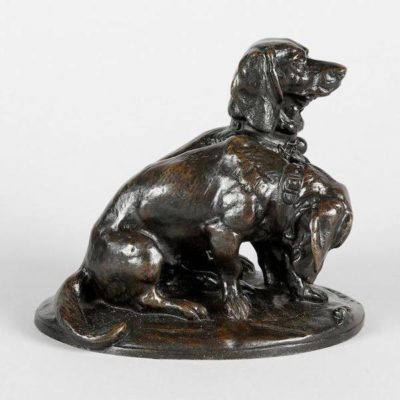
Imagine owning the same breed that sat at the feet of a king, a queen, or a famous historical figure?
Many of us can, of course, and those who own a Basset Artésien Normand can appreciate what Emperor Napoleon III saw in the breed because he was a Basset Artésien Normand fancier whose patronage boosted the breed’s popularity in France. A year after he began his reign as emperor (1852 to 1870), he commissioned the leading sculptor of animals in the day, Emmanuel Fremiet, to sculpt bronzes of three of his dogs (one of Fremiet’s sculptures of Napoleon’s dogs is seen here). But we’ve gotten ahead of ourselves.
At one time, Bassets strains from Normandy were crooked legged, while those from Artois were straight legged. Breeders worked to combine them into one breed, the Basset Artésien Normand, but when the breed was shown at the Paris dog show in 1863, there were still four varieties of it: Wire-coated dogs were known as Basset Griffons, smooth-coated ones were known as Basset Francais, and each coat variety came in two leg lengths.
Basset Artésien Normand breeding became standardized in 1870, but two prominent breeders of the day had their own respective lines, and those lines became quite different from each other. Eventually, a chap named Leon Verrier combined aspects of both lines after creating one unified breed standard. He did such a good job that only one variety of Basset Artésien Normand remains today, the smooth coated, short-legged modern variety.
Our reading tells us that one differences between a Basset Hound and the Basset Artésien Normand comes down to weight (the Basset Hound is heavier), height (the Basset Artésien Normand is typically shorter), skin (the Basset Hound has extra skin, or more “sagging”), head (Basset Hounds have a well-formed and distinct occiput while the Basset Artésien Normand’s skull is pretty flat), ear set (the Basset Hound has a lower ear set than the Basset Artésien Normand’s), and eyes (the Basset Artésien Normand’s eyes are round and lack the haw that gives Basset Hounds their trademark “doleful” expression).
The Basset Artésien Normand is a delightful “walking hound,” which means that the dog can be followed by the hunter on foot since short legs mean a shorter stride. Although rare outside of its native country, the Basset Artesian Normand is the most common breed of Basset in France.
Image: Bronze Dog Sculptures of “Ravegeot et Ravageole, Napoleon’s Two Favorite Bassets c. 1850 by Emmanuel Fremiet (1824-1910)
